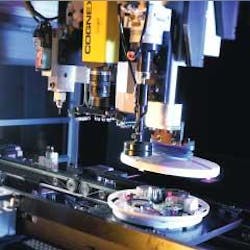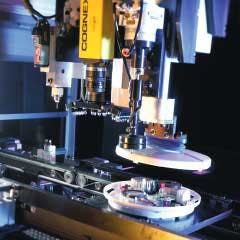Robots and vision team for automated assembly
Many manufacturers are looking to automate traditionally manual, back-end assembly processes to realize cost, quality, and throughput improvements. Because their products may involve a number of complex parts that must be automatically assembled, the manufacturers require systems integrators to deliver solutions that can easily be installed, configured, and deployed.
These systems may be required to perform multiple automated fastening, material dispensing, barcode reading, parts pick and placement, and quality control. To do this, companies have developed assembly cells that incorporate a number of standard interfaces to allow a range of tools to be added or removed in response to product changes.
Using a combination of custom materials-handlingand off-the-shelf vision systems, UIC Polaris Assembly Cell can perform multiple automated-fastening, material-dispensing, barcode-reading, parts pick-and-placement, and quality-control functions.
At this year’s Assembly Technology Exposition show (Chicago, IL, USA), Universal Instruments Corp. (UIC; Binghamton, NY, USA; www.uic.com), a provider of integrated systems, showed how its range of Polaris Multi-Process Assembly Cells had been developed using a combination of custom-built and off-the-shelf vision components. The Polaris Assembly Cell adopts Universal Instruments’ modular platform philosophy, meaning several processes can be performed in a single cell or distributed across multiple cells to boost productivity.
“In the Polaris Assembly Cell,” says Stan Earley, manager of the Odd Form & Final Assembly division, “multiple operations can be performed by incorporating up to three independent tool modules and a vision inspection system. These modules can be tailored for driving screws, pick and placement of mechanical piece parts and assemblies, and dispensing different materials using a variety of valve types, label placement, barcode reading, and machine vision.”
In a typical automated system, parts must be placed from a bin onto an assembly line. This requires an intelligent system that incorporates motion control, robotics, and vision systems. In the Polaris, a Cartesian robot, built using LH and LS linear guides from NSK (Ann Arbor, MI, USA; www.am.nsk.com), is mounted with both an RS-170 camera from Panasonic Vision Systems (Secaucus, NJ, USA; www.panasonic.com) and an In-Sight 1000C from Cognex (Natick, MA, USA; www.cognex.com).
To perform image capture from the RS-170 camera, the system incorporates an AdeptVision sAVI inspection system from Adept (Livermore, CA, USA; www.adept.com). This controller incorporates proprietary software for capturing, processing, analyzing, displaying, and archiving images and networking and general-purpose I/O capability. The sAVI controller positions the UIC robot over the field of view of parts to be placed on a Flexlink (Göteborg, Sweden; www.flexlink.com) conveyor system, which is based on an aluminum conveyor beam with low-friction slide rails guiding a plastic multiflexing chain. Products can travel directly on the conveyor or on attached pallets.
To determine the orientation of each part in the bin, images captured by the RS-170 camera are digitized by a custom Matrox (Dorval, QC, Canada; www.matrox.com/imaging) PCI frame grabber housed in the sAVI controller. Custom data-driven software tools developed by UIC using the standard vision algorithms available with the Adept controller determine position and orientation of the assembly on the conveyor. This information is used by the Cartesian robot to correct the placement locations.
“After parts are placed on the conveyor,” says Earley, “the robotic system is used in a similar manner to place other parts with a vacuum spindle, servo gripper, or combination of both. In this manner, mechanical parts, covers or lids, labels, and electronic circuit boards can be automatically assembled. Polaris could, for example, dispense a gasket, pick and place a cover, and screw the cover in place-all within the same automated cell.”
To perform optical character recognition (OCR), optical character verification (OCV), component piece part inspection/correction, or product fiducial or pattern inspection, the system uses an In-Sight 1000C interfaced to the system via an Ethernet hub; this camera can be used for OCR/OCV on parts before or as they are transferred to the conveyor system.
“In this way,” says Earley, “quality control can be assured at multiple stages in the automation process.” In operation, a product barcode could be matched to a pallet code and the correlation information sent via Ethernet to a factory information system for tracking. The reader can also provide 1-D or 2-D matrix verification of an existing or just-placed label, and the data can be used to separate accepted or rejected product.

